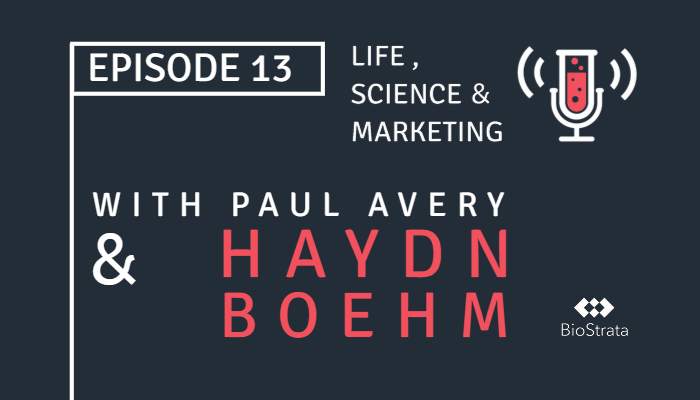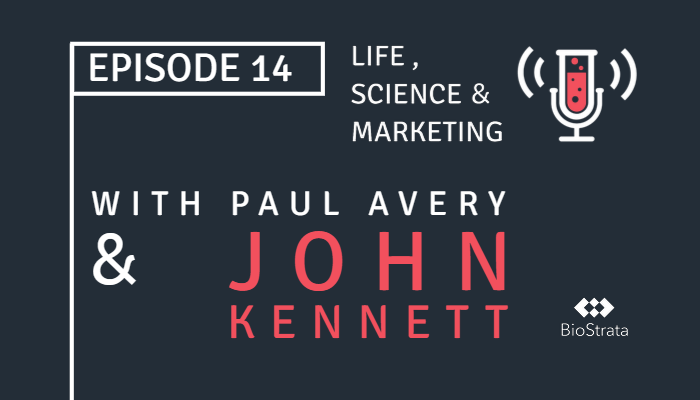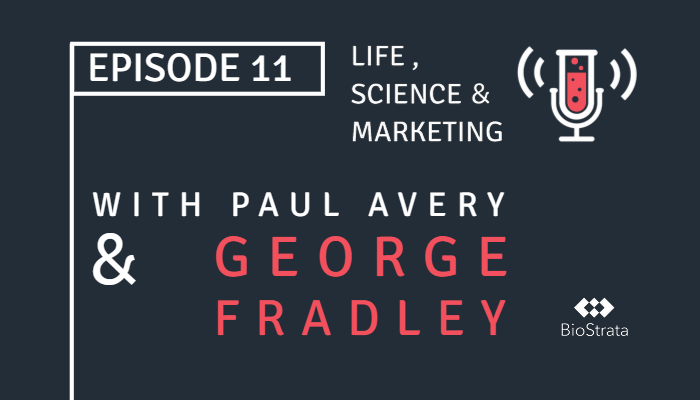Haydn Boehm: Applying a scientist's curiosity to continuous marketing experimentation and the impact of AI on pharmaceutical R&D
The "Life, Science and Marketing" podcast, hosted by BioStrata CEO Paul Avery, offers thought-provoking dialogues with leading marketing professionals in the life sciences field. Each instalment invites guests to explore their personal and professional journeys, sharing expertise and recommendations on marketing tactics and industry best practices.
In our latest episode, host Paul Avery speaks with Haydn Boehm, an expert marketer who leverages his background in chemistry and the scientific method to continuously improve marketing efforts. With over 20 years spanning roles in technical sales, product management, and marketing, Haydn shares how he employs an experimental, data-driven approach to marketing strategy.
In their wide-ranging discussion, Haydn and Paul explore how the rise of digital channels has shifted organisations from being sales-led to marketing-led. Haydn explains how marketers can identify the right content to reach audiences where they go to learn, while respecting the introverted nature of many scientists. He also offers perspectives on lead nurturing, inbound vs. outbound tactics, and the promise and limitations of AI in drug discovery.
Tune into their insightful conversation below to hear Haydn's unique takes on marketing experimentation, leveraging data to demonstrate value, and tailoring content to move prospects along their buyer's journey.
How did you get to where you are today in your career?
Haydn Boehm: I got to where I am today through a combination of curiosity, realising when I wasn't clever enough in certain areas, and developing strong communication skills. I started with a PhD in organic chemistry, but realised in the lab that while I was good at communicating science, I didn't have the deep skills to be "the molecule person."
So I explored other options like auditioning for BBC science talent programs, which led me to try out medical sales. I enjoyed aspects of sales but struggled with no longer feeling like a scientist. So I went back into the lab, but still felt unsettled and that my skillset wasn't best matched there. I eventually found a good fit in scientific sales roles at companies like Sigma Aldrich, which allowed me to leverage both my science background and my communication strengths. From there I gradually moved further up the chain into marketing and product marketing, where I am today.
What was the transition from sales to marketing like for you?
Haydn Boehm: The transition was smooth in some ways because having been in sales, I knew that marketing should ultimately enable sales and move customers along their buying journey. Since I didn't have a formal marketing background, I took a curious, problem-solving approach to learning on the job. I read a lot about marketing theories and treated every campaign or initiative like an experiment to test hypotheses and refine based on results.
My scientific mindset was helpful here too - I didn't rely solely on textbook marketing ideas but rather tried to always question assumptions and whether established ideas still made sense in a changing technology landscape and for evolving customer expectations. So I was able to bring fresh eyes to challenges even without traditional training.
How has marketing changed, especially in the life sciences?
Haydn Boehm: Marketing used to be mainly about supporting sales - making brochures, "coloring in" for the sales team. Companies were very sales-led. But technology has profoundly changed buying journeys and experiences. Today buyers, especially scientists, prefer to research on their own first, rather than talk to sales reps early on.
So now marketing plays a bigger role earlier in that journey - attracting interest, providing education, generating credibility way before a prospect talks to a salesperson. The sales role becomes more specialised, focused on final negotiations rather than hunting for prospects. So organisations need to shift from being sales-led to marketing-led to align with buyer preferences.
Does lead nurturing actually work? What should good lead nurturing entail?
Haydn Boehm: I think whether lead nurturing works depends on what you're selling and trying to achieve. For a catalog reagent company, the value proposition is already well understood, so it's more about brand awareness and service. But for a new product that changes how people work, lead nurturing is very viable for piquing interest and driving adoption.
We had success with lead nurturing at Merck for a digital lab product by creating personas and mapping out typical buying group decision makers. We tailored content specifically to reach and resonate with different roles - end users vs. procurement vs. executives - about how the product impacted their particular pain points.
Rather than relying solely on email, we published content in industry trade journals that people were already subscribed to and engaged with. When they clicked for more info, we could then continue nurturing. Following up further only when they demonstrated intent through multiple content interactions. So good lead nurturing recognises your solution means different things to different roles, uses multiple appropriate channels to reach them, and doesn't over-email those showing little interest.
Is outbound sales prospecting making a comeback in the life sciences?
Haydn Boehm: I think we're seeing a resurgence of outbound in part due to post-COVID desperation since sales reps couldn't meet prospects face-to-face. It may also indicate that companies never fully embraced inbound marketing principles - they're defaulting back to old school interruption selling because it's familiar.
However, done right, outbound can be much more effective by tailoring value messaging specifically to each prospect's role. For example, productivity means something very different to end users, middle management, and executives. Outbound is typically spray and pray with no personalisation. But you need to speak to the specific pains and existing productivity drains for each audience. So rather than blanket outbound spamming, I think sales prospecting needs to evolve to insight-led, targeted outreach that shows clear understanding of individual value.
What impact is AI having or expected to have on pharmaceutical R&D?
Haydn Boehm: There's a lot of buzz about AI in drug discovery, but more hype than reality so far. The rules of something like the AlphaGo game are fully defined, but we still have limited visibility on human disease physiology and trials. So while AI is very advanced for modeling molecules and screening compounds, the end-to-end success rate for AI-derived drugs making it through trials remains near zero.
However, AI is transforming earlier research stages. Technologies like computational chemistry have leveraged AI for decades to narrow down molecule candidates worth physically screening from tens of millions to hundreds. AI both improves R&D productivity and enables outsourcing that part of the value chain. So while still unproven for clinical candidates, AI is already accelerating upstream discovery. The next breakthrough may come as we incorporate more real world patient data to enhance disease models.
So in summary, AI is driving reassessment across the industry - what constitutes a biotech? what should in house vs. outsourced R&D look like? what is the optimal investment strategy? It's an exciting time, but AI still has a long way to go to clinically validate revolutionary new medicines.
Learn more with the Life, Science & Marketing Podcast
As we wrap up this insightful discussion with Haydn Boehm, we thank him for sharing his unique perspectives on applying scientific principles to advance marketing efforts. With his blend of technical expertise and marketing savvy, Haydn offered thoughtful takes on experimentation, data analysis, content strategy, and more.
Haydn welcomes further conversations and questions via LinkedIn, where you can connect with him directly. In the meantime, stay tuned for future episodes of our "Life, Science and Marketing" podcast for more strategic advice from marketing leaders across the life sciences.
You can also follow us on official Life, Science and Marketing LinkedIn pageor your favourite podcast platform to keep up with the latest episodes and commentary on optimising marketing impact. We aim to provide an ongoing source of ideas and best practices for our audience of scientific marketers





